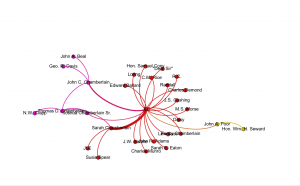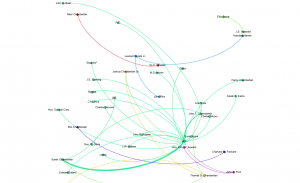The Undergraduate Network for Research in the Humanities is a student-created and student-run conference. A group of undergraduates had attended other Digital Humanities conferences in the past, but felt as though those conferences did not give students enough time to discuss research projects, methods, and tools directly with one another. As a result, the Undergraduate Network for Research in the Humanities was created to give students the space to present research projects to one another and to encourage future collaboration between the participants. Participants have the chance to bring what they discussed at the conference back to their respective colleges in order to contribute to the growth of digital humanities.
This past November, I was selected to attend the inaugural conference along with one other Bowdoin student at Davidson College in North Carolina. The first session was titled “Speed Dating” and all the attendees had two minutes to share key findings from their research and explain the digital and computational tools used in their project. I was excited but also surprised to learn about the breadth of research possibilities across many different institutions (each college’s digital humanities program seems to be run somewhat differently, although there are certainly discernible overlaps). The range of projects included digitizing an ancient tomb, studying ethnography through digital sound, and creating an interactive timeline of the Earl of Essex. Since the field is still so new and is only going to continue to grow, attendees were able to build on the knowledge of other students by sharing diverse research projects that employed a wide range of digital and computational tools.
I was able to present the research that I had worked on with Professor Hall this summer as one of the six longer presentations. The project is titled, “What Could Joshua Chamberlain See at Gettysburg?” and explores the relationship between present and historical narratives using computational tools such as Gephi and arcGIS.
Later in the conference, Keynote Whitney Trettien gave a talk titled Off the Books: Digital Futures. She discussed her own path through the field of digital humanities, and it was extremely informative to see where our work in this field could lead after graduation. She also emphasized her desire to balance physical books and digital ones throughout her work.
The conference served as an ideal starting point to collaborate with other students and learn more about digital humanities that I could then apply at Bowdoin. At the end, there was a design thinking session titled “How might we re imagine the undergraduate humanities research model in the digital age?”, which encouraged everyone to think about what research could look like going forward. The attendees are still in communication with one another and I think there is a great possibility for future undergraduate collaborations in the digital humanities.

